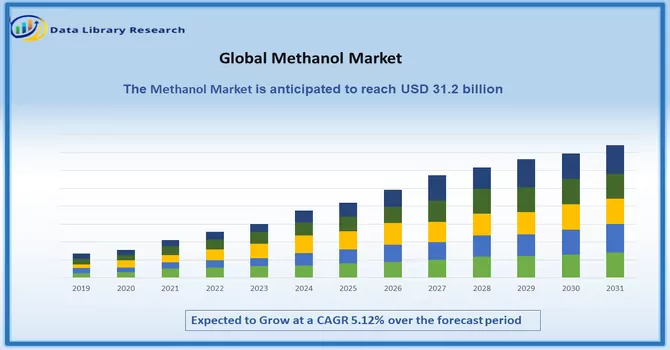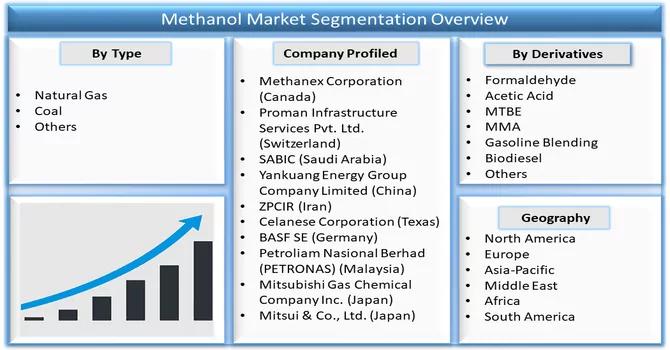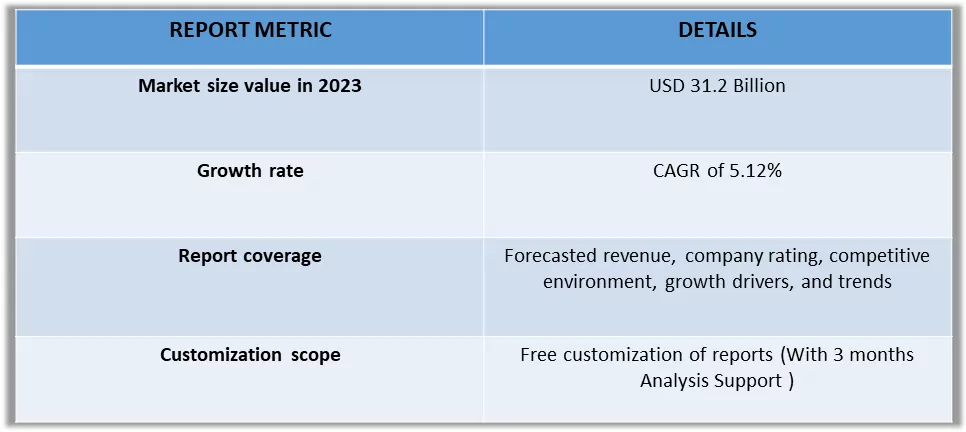The global methanol market was valued at USD 31.2 billion in 2023 and is projected to reach a 5.12% CAGR during the forecast period 2024-2031.

Get Complete Analysis Of The Report- Download Free Sample PDF
The global methanol market is witnessing robust growth driven by a confluence of factors. Methanol, a versatile chemical, serves as a crucial building block for various industrial applications, including chemicals, fuels, and materials. The market is propelled by the increasing demand for methanol as a feedstock in the production of chemicals like formaldehyde, acetic acid, and olefins. Additionally, the rising popularity of methanol as an alternative fuel, particularly in the transportation sector, is contributing to market expansion. Governments across the globe are emphasizing the use of cleaner and sustainable energy sources, driving the adoption of methanol-based fuels.
Furthermore, the development of new technologies and processes for methanol production is enhancing efficiency and reducing environmental impacts, further fueling market growth. However, challenges such as volatility in raw material prices and the environmental impact of methanol production processes present hurdles for market players. Amid these dynamics, the global methanol market is poised for continuous evolution, driven by innovation, sustainability, and the ongoing transition towards cleaner energy solutions. The global methanol market is experiencing robust growth, primarily fueled by several key factors. One of the significant drivers is the increasing demand for methanol as a feedstock in various chemical manufacturing processes. Methanol serves as a vital component for producing chemicals like formaldehyde, acetic acid, and olefins, driving its usage across diverse industries. Moreover, the rising adoption of methanol as an alternative fuel is contributing to market expansion, especially in the transportation sector. Governments worldwide are promoting cleaner and sustainable energy solutions, with methanol emerging as a viable option. Additionally, technological advancements in methanol production processes are enhancing efficiency and reducing environmental impacts, further propelling market growth. As the industry continues to innovate and address sustainability concerns, the global methanol market is poised for sustained growth in the foreseeable future.
Market Segmentation: Global Methanol Market, By Type (Natural Gas, Coal, and Others), Derivatives (Formaldehyde, Acetic Acid, MTBE, MMA, Gasoline Blending, Biodiesel, DME, TAME, DMT, MTO/MTP, Others), and Geography (North America, Europe, Asia-Pacific, South America, and Middle-East and Africa).

For Detailed Market Segmentation - Download Free Sample PDF
The global methanol market is witnessing notable trends that are shaping its landscape. One prominent trend is the increasing focus on sustainable and eco-friendly methanol production methods. With a growing emphasis on environmental responsibility, manufacturers are adopting greener processes, such as bio-methanol production and carbon capture technologies. Another significant trend is the expanding application of methanol in energy storage solutions, particularly as a fuel for fuel cells. The versatility of methanol as an energy carrier aligns with the global push for cleaner energy sources. Additionally, the market is experiencing a surge in demand from emerging economies where methanol is utilized in diverse industries, including automotive, construction, and electronics. As technological advancements continue to unfold, and environmental considerations gain precedence, the global methanol market is evolving with these dynamic trends, positioning itself for sustained growth and innovation.
Market Drivers:
Increasing Demand in Chemical Production
One of the primary drivers for the global methanol market is the escalating demand for methanol in chemical manufacturing processes. Methanol serves as a crucial feedstock for various chemicals, including formaldehyde, acetic acid, and olefins. The expanding chemical industry, driven by diverse applications in plastics, textiles, and pharmaceuticals, contributes significantly to the rising demand for methanol as a key raw material. The versatile nature of methanol positions it as an essential component in the synthesis of numerous chemical compounds, driving its consumption across different industrial sectors.
Growing Adoption in Alternative Fuels
The global push for cleaner and sustainable energy sources is propelling the use of methanol as an alternative fuel. Methanol is gaining traction as a potential green energy carrier, particularly in the transportation sector. As countries aim to reduce their dependence on traditional fossil fuels, methanol stands out as a viable option due to its lower carbon footprint. Methanol-powered vehicles and fuel cells are emerging as sustainable solutions, providing a cleaner energy alternative. This shift towards alternative fuels is a significant driver for the global methanol market, fostering innovation and investment in methanol-based energy applications.
Market Restraints:
The global methanol market faces certain challenges that can impede its seamless growth. One notable restraint is the volatility in raw material prices, particularly in the case of natural gas and coal, which are primary feedstocks for methanol production. Fluctuations in the prices of these raw materials can significantly impact the overall production cost of methanol, posing challenges for manufacturers in maintaining stable pricing structures. Additionally, the methanol market is subject to stringent regulations related to environmental and safety standards, as methanol production and handling involve inherent risks. Compliance with evolving regulations requires continuous investment in technology and infrastructure to ensure a safe and sustainable production process. Furthermore, the market may encounter competition from alternative fuels and chemicals, influencing the demand dynamics for methanol. Addressing these challenges will be essential for sustaining growth and fostering resilience in the global methanol market.
The global methanol market experienced a nuanced impact from the COVID-19 pandemic. The initial phases of the pandemic led to disruptions in the supply chain, affecting the production and distribution of methanol. Lockdowns, restrictions on movement, and reduced industrial activities resulted in a decline in demand for methanol across various end-use sectors, including automotive, construction, and manufacturing. The energy sector, a significant consumer of methanol, faced setbacks due to reduced transportation and construction activities during the pandemic.However, as economies adapted to the new normal and implemented safety measures, the methanol market showed signs of recovery. The increasing demand for renewable energy sources and the growing emphasis on sustainability provided opportunities for the methanol market, especially in applications like biodiesel production and as a feedstock for chemicals. The pandemic underscored the importance of flexibility and resilience in supply chains, prompting stakeholders in the methanol industry to reevaluate and strengthen their strategies. Overall, the global methanol market demonstrated resilience, with the evolving landscape presenting both challenges and avenues for innovation and growth.
Segmental Analysis:
Natural Gas Segment is Expected to Witness Significant Growth over the Forecast Period
Natural gas is a key feedstock in the production of methanol, serving as the primary source of hydrogen and carbon needed for the methanol synthesis process. Methanol production typically involves the catalytic conversion of natural gas into synthesis gas (syngas), which is a mixture of hydrogen, carbon monoxide, and carbon dioxide. This syngas is then further processed over a catalyst to produce methanol. The use of natural gas in methanol production offers several advantages. Natural gas is abundant and relatively inexpensive compared to other feedstocks, making it a cost-effective option for methanol production. Additionally, natural gas-based methanol has a lower carbon footprint compared to methanol produced from coal or other fossil fuels, making it a more environmentally friendly option. Moreover, natural gas-based methanol is a versatile chemical that serves as a building block for various products, including formaldehyde, acetic acid, and plastics. This versatility has led to an increasing demand for natural gas-based methanol in various industries, including automotive, construction, and electronics. Thus, natural gas plays a crucial role in the production of methanol, offering a cost-effective, environmentally friendly, and versatile feedstock for the production of this important chemical.
Formaldehyde Segment is Expected to Witness Significant Growth over the Forecast Period
Formaldehyde derivatives are chemicals that are derived from formaldehyde, which is produced from methanol. Formaldehyde is a key building block in the chemical industry and is used to manufacture a wide range of derivatives that have various industrial and commercial applications. One of the most common formaldehyde derivatives is urea-formaldehyde resin, which is used as an adhesive in the production of wood products such as plywood, particleboard, and medium-density fiberboard. Urea-formaldehyde resin provides strong bonding properties and water resistance, making it ideal for use in these applications. Another important formaldehyde derivative is phenol-formaldehyde resin, which is used in the production of coatings, adhesives, and molded products. Phenol-formaldehyde resin offers excellent heat resistance and electrical insulation properties, making it suitable for use in high-temperature applications and electrical components. Other formaldehyde derivatives include melamine-formaldehyde resin, which is used in the production of laminates, coatings, and adhesives, and paraformaldehyde, which is used as a disinfectant and preservative. Thus, formaldehyde derivatives obtained from methanol play a crucial role in various industries, providing essential properties such as adhesion, durability, and thermal resistance in a wide range of applications.
North America Region is Expected to Witness Significant Growth Over the Forecast Period
North America is a significant player in the global methanol market, both as a producer and a consumer. The region is home to several major methanol producers, including plants in the United States, Canada, and Mexico. In terms of production, the United States is the largest methanol producer in North America, with several large-scale methanol plants located across the country. These plants utilize a variety of feedstocks, including natural gas and coal, to produce methanol for both domestic use and export. Canada also has a significant methanol production capacity, primarily from plants located in Alberta and British Columbia. These plants use natural gas as the primary feedstock for methanol production. Mexico is another important player in the North American methanol market, with several methanol plants located throughout the country. These plants primarily use natural gas as a feedstock and produce methanol for both domestic consumption and export. In terms of consumption, North America is a major market for methanol, with a wide range of industries utilizing methanol as a feedstock or chemical intermediate. The region's diverse industrial base, including sectors such as chemicals, plastics, automotive, and construction, drives the demand for methanol in North America.Thus, North America plays a critical role in the global methanol market, with significant production capacity and a diverse range of industrial applications driving both production and consumption in the region.

Get Complete Analysis Of The Report- Download Free Sample PDF
The analyzed market exhibits a high degree of fragmentation, primarily attributable to the presence of numerous players operating on both a global and regional scale. The competitive landscape is characterized by a diverse array of companies, each contributing to the overall market dynamics. This fragmentation arises from the existence of specialized solution providers, established industry players, and emerging entrants, all vying for market share. The diversity in market participants is underscored by the adoption of various strategies aimed at expanding the company presence. On a global scale, companies within the studied market are strategically positioning themselves through aggressive expansion initiatives. This often involves entering new geographical regions, targeting untapped markets, and establishing a robust global footprint. The pursuit of global expansion is driven by the recognition of diverse market opportunities and the desire to capitalize on emerging trends and demands across different regions. Simultaneously, at the regional level, companies are tailoring their approaches to align with local market dynamics. Regional players are leveraging their understanding of specific market nuances, regulatory environments, and consumer preferences to gain a competitive edge. This regional focus allows companies to cater to the unique needs of local clientele, fostering stronger market penetration. To navigate the complexities of the fragmented market, companies are implementing a range of strategies. These strategies include investments in research and development to stay at the forefront of technological advancements, mergers and acquisitions to consolidate market share, strategic partnerships for synergies, and innovation to differentiate products and services. The adoption of such multifaceted strategies reflects the competitive nature of the market, with participants continually seeking avenues for growth and sustainability. In essence, the high fragmentation in the studied market not only signifies the diversity of players but also underscores the dynamism and competitiveness that drive ongoing strategic maneuvers. As companies explore various avenues for expansion, the market continues to evolve, presenting both challenges and opportunities for industry stakeholders.
Some of the key maket players working in this segment are:
Recent Developments:
1) In November 2022, Petronas began construction on a new methanol facility in Bintulu Sarawak, Malaysia, which will add 1.75 million tons of production capacity to its existing 2.4 million tons. The project is scheduled for completion in March 2023.
2) In February 2022, Linde expanded its agreement with Celanese Corporation to supply carbon dioxide and hydrogen to Celanese's manufacturing facility in Clear Lake, Texas, for methanol production. This move aims to reduce carbon emissions during operations, aligning with environmental preservation goals and enhancing Linde's business portfolio.
Q1. What was the Methanol Market size in 2023?
As per Data Library Research the global methanol market was valued at USD 31.2 billion in 2023.
Q2. At what CAGR is the Methanol market projected to grow within the forecast period?
Methanol is projected to reach a 5.12% CAGR during the forecast period.
Q3. What are the factors on which the Methanol market research is based on?
By Type, By Derivative and Geography are the factors on which the Methanol market research is based.
Q4. Which region has the largest share of the Methanol market? What are the largest region's market size and growth rate?
North America has the largest share of the market. For detailed insights on the largest region's market size and growth rate request a sample here.
Data Library Research are conducted by industry experts who offer insight on industry structure, market segmentations technology assessment and competitive landscape (CL), and penetration, as well as on emerging trends. Their analysis is based on primary interviews (~ 80%) and secondary research (~ 20%) as well as years of professional expertise in their respective industries. Adding to this, by analysing historical trends and current market positions, our analysts predict where the market will be headed for the next five years. Furthermore, the varying trends of segment & categories geographically presented are also studied and the estimated based on the primary & secondary research.
In this particular report from the supply side Data Library Research has conducted primary surveys (interviews) with the key level executives (VP, CEO’s, Marketing Director, Business Development Manager and SOFT) of the companies that active & prominent as well as the midsized organization
FIGURE 1: DLR RESEARH PROCESS

Extensive primary research was conducted to gain a deeper insight of the market and industry performance. The analysis is based on both primary and secondary research as well as years of professional expertise in the respective industries.
In addition to analysing current and historical trends, our analysts predict where the market is headed over the next five years.
It varies by segment for these categories geographically presented in the list of market tables. Speaking about this particular report we have conducted primary surveys (interviews) with the key level executives (VP, CEO’s, Marketing Director, Business Development Manager and many more) of the major players active in the market.
Secondary ResearchSecondary research was mainly used to collect and identify information useful for the extensive, technical, market-oriented, and Friend’s study of the Global Extra Neutral Alcohol. It was also used to obtain key information about major players, market classification and segmentation according to the industry trends, geographical markets, and developments related to the market and technology perspectives. For this study, analysts have gathered information from various credible sources, such as annual reports, sec filings, journals, white papers, SOFT presentations, and company web sites.
Market Size EstimationBoth, top-down and bottom-up approaches were used to estimate and validate the size of the Global market and to estimate the size of various other dependent submarkets in the overall Extra Neutral Alcohol. The key players in the market were identified through secondary research and their market contributions in the respective geographies were determined through primary and secondary research.
Forecast Model
